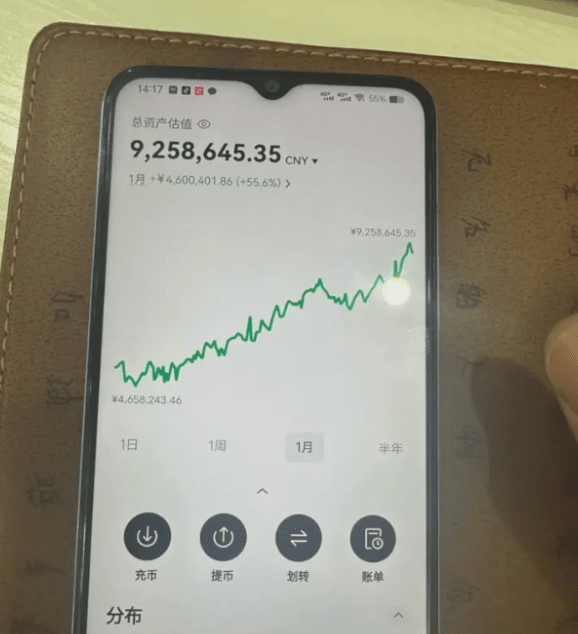A big player who has earned 40 million over ten years in the crypto space tells you what to pay attention to!
In fact, once you grasp trading cryptocurrencies, life feels like enlightenment!
Ten years ago, when I first entered the crypto space, like most retail investors, losses and profits seemed entirely based on luck, with no discernible patterns.
But after spending a few years in the crypto space, through continuous learning and absorption, with mentors and seniors constantly sharing and guiding, I finally began to understand and form my investment system!
Today I will share my trading strategies and insights with friends in the crypto space.
Survival in the crypto space requires mastering these 14 'survival algorithms':
1. Risks cannot be avoided; the more you run, the tighter it clings; opportunities are like meteors; hesitating means missing the galaxy.
2. Long-term positions are the ballast, stabilizing the fundamentals; short-term positions are the agile sails, capturing fleeting gains; swing trades are precision nets, catching fat fish in the tides.
3. Leave some margin in your account, like a seam left in a ship's hull—steering through storms is easy; if your mindset collapses, you won't catch any good trends.
4. Investing is like sharing a cake; don't take the whole plate away. Leave a piece for the market and competitors, which can instead allow you to eat every time; greedy people often break the plate.
5. Frequent trading is 'self-harming order placement'; fees eat into your capital; hesitation and observation lead to 'chronic financial leakage'; when the opportunity slips away, the losses are already booked.
6. Mindset is the 'operating system' of trading; when it stalls, no strategy will work. Be as calm as an 'anti-shake lens'; even a blurred market can reveal its context.
7. The market sprouts at the 'freezing point,' growing wildly amidst skepticism, and concludes with a public celebration. Step on the switch of emotional 'temperature curve' accurately.
8. Greed is a 'black hole' for profits; wanting to earn 20 from 10 leads to losses; fear is a 'firewall' for opportunities; when it's time to enter, you lock the door. Install a 'pressure relief valve' for emotions.
9. A decline is not an abyss; it's the market 'dumping' chips. Cash is like an admission ticket; wait until it’s discounted to buy.
10. Buy with a 'telescope' for the long term, hold with a 'magnifying glass' to ignore fluctuations, sell with a 'scalpel' when it's time to cut losses.
11. Indicators are 'market translators'; those who understand read the subtext, while those who don't are misled by the literal meaning. Don’t be a parrot; strive to be an interpreter.
12. Stop-loss is the 'airbag'; it seems inconspicuous usually, but it saves lives during a collision. Accounts without stop-loss are like cars without brakes; they will eventually fall off a cliff.
13. Market sentiment is a 'reverse compass': when the masses shout 'run,' bend down to pick up chips; when the older generation flaunts profits, quietly move towards the exit.
14. Newcomers chase candlesticks like chasing shadows; veterans focus on trading volume to gauge 'popularity'; experts sense 'market breathing' to discern trends. Upgrading cognition is the ticket to traversing bull and bear markets.

What kind of game is trading in the crypto space?
It is a life-and-death game where money acts as soldiers.
When you win, your soldiers increase; when you fail, your soldiers decrease.
What you earn is what others lose; what you lose is what others earn.
Others will release various messages to create emotions, sending your soldiers to plunder.
But later you will find that this place is full of traps; once you buy, it drops, and your soldiers are taken away.
The opportunities you favor are actually traps set intentionally, just waiting for you to step in.
Moreover, it often shows you the myth of sudden wealth, like turning 20,000 USDT into 30 million USDT.
Why do retail investors love to read such stories? Because they are poor; being poor makes them anxious, anxious to get rich quickly.
And so greed takes over, leading to reckless trading, gambling, and leveraging.
They thought it was a trading failure; in reality, they were scammed.
If you really want to trade, focus on BTC; it’s hard to manipulate.
Others, including ETH, are not viable.
If you want to trade in other coins, then you need an informational advantage.
Information advantage can be insider information, summaries and thoughts from many experienced individuals, or your unique analysis.
In short, if you want to make money, you need to have an advantage, even if it's just 1%. You can also engage in speculation.
Otherwise, you will feel good, hearing others say it's good, and just go buy it.
You were deceived because of your greed and ignorance.
The crypto space is filled with fraud; making money is not that easy.
Rather than calling it a new type of financial market, it’s better to say it’s a global on-chain casino.
There is no fairness here; the myth of sudden wealth is just something you hear occasionally.
The purpose is to attract traffic; anything that makes you see and feel confident is what others want you to see and feel confident about.
If you don't have unique abilities, then don't trade cryptocurrencies.
If you have the ability, you naturally know that trading cryptocurrencies is merely an amplifier of human nature.

Crypto liquidation prevention mindset: stabilize your ship in the storm.
Dear maritime adventurers of the crypto space:
In this 24-hour unceasing digital ocean, we have witnessed too many ships sink. The alarms of liquidation sound repeatedly, but there are always some people whose accounts stand firm like rocks in the deep sea, unaffected by the storms. Today, I want to share the mindset of these survivors with you.
The first warning: never fall in love with your position.
The market has no feelings; it won’t change direction because of your persistence. When you find yourself starting to make excuses for a certain coin, that’s the beginning of danger. Remember, in the crypto space, loyalty is the greatest luxury, and timely stop-loss is the highest level of self-discipline.
The second warning: leverage is a double-edged sword, not a lifeline.
A 3x leverage can already give you the thrill of a racing heart; why pursue 20x overnight wealth? True trading experts understand that controlling desire is more important than predicting the market. Treat leverage as a seasoning, not the main dish; your account will thank you for your restraint.
The third warning: the market never lacks opportunities, but your capital only has one chance.
FOMO is the best catalyst for liquidation. When everyone is shouting 'this time is different,' it is often when you should be most cautious. Remember, you can live after missing an opportunity, but a single liquidation might mean you're out for good.
The fourth warning: establish your 'liquidation prevention checklist.'
No single coin position should exceed 5% of total capital.
Keep the overall leverage ratio below 3 times in the long term.
Set automatic stop losses and adhere to them as strictly as you would obey the law.
During weekly reviews, first look at losing trades, then look at profitable trades.
During emotional fluctuations, stay away from the trading interface for at least 4 hours.
The fifth warning: treat liquidation as a mandatory lesson, not a graduation ceremony.
Every veteran in the crypto space has experienced liquidation; the difference is that some treat it as tuition, while others see it as the end. After each liquidation, write down three lessons learned; these hard-earned experiences are more valuable than any analysis from influencers.
Dear friends, the essence of the wealth game in the crypto space is cognitive monetization, while liquidation is often the moment of cognitive failure. In this battlefield without gunpowder, the real winners are not those who predict best, but those who control risks best.
May you remain clear-headed in this crazy world; remember to fear when others are greedy, and stay rational when others are fearful.
Remember, living longer is the greatest superpower in the crypto space.
I once thought trading could lead to quick wealth, but later realized it is actually a long-term battle with oneself—no one can always be ahead; those who remain are those who continuously refine and evolve.
Over the years in the market, I've learned not just techniques but more about insights into human nature, respect for risk, and discipline. From blindly following trends to establishing a system, from emotional trading to mechanical execution, each step of growth has been accompanied by hardship and trials.
The market is fair; it does not directly punish mistakes but will repeatedly teach you until you learn.
There are no secrets to trading, and the market holds no secrets. The key to making money is right in front of you: trends, support and resistance, position management, and execution. Repeating these simple things to perfection is enough.
Stop guessing ups and downs; instead, manage the present. Trading does not rely on predictions, but on execution. You don't know the profit or loss of the next trade, but by adhering to the rules long-term, probability will eventually be on your side.
Let profits run, and let losses stop. You must first accept losses to be able to make money. Holding onto losses is the most dangerous; profits rely on seizing the right opportunities.
Being too close to the market can easily consume you. Constantly watching the market and trading frequently will only increase anxiety. Those who truly make money understand the importance of maintaining distance from the market and learn to wait for the trends that belong to them.
True experts can endure boredom and loneliness. Stable profit-makers often have very dull trading; their rules remain unchanged, execution is steady, and they are not swayed by emotions.
Trading is a marathon; living longer is more important than running faster. You don't need to be the smartest; just outlive others. Manage risk, control drawdown, stay in the market, and time will reward you.
Ultimately, trading is about continuously refining oneself. The market will not change; the only thing that can change is you. What determines profit is the depth of your understanding and your execution ability. Once you grasp these, you no longer need others to point it out— the market has already taught you everything.

The shocking truth about averaging down in the crypto space: 90% of people are just blindly averaging down. Experienced traders will help you calculate the true cost. Here are four cruel truths about investing that can help you reduce losses.
Averaging down is not simply 'the average price.'
For example, if you buy 10 units for 10,000, and then buy another 10,000 when the price drops to 5, you think your cost is 7.5? Wrong! The actual cost is 6.67 because the second purchase quantity is larger, reducing the average price.
Key point: After averaging down, your cost is lower than you think, but don't feel 'safe' because of it; you still need to stop loss when necessary.
Earn 1% daily, can you turn it into ten times in a year?
With 100,000 capital, earning 1% daily, over 250 days a year, compounded, can turn into 1.32 million.
But the reality is: very few can consistently earn 1% daily; most earn 5% today and lose 10% tomorrow, ultimately achieving nothing. Self-discipline is more important than strategy.
Can a 60% success rate still make money?
If you trade 100 times:
60 profitable trades, each earning 10% → total profit of 60%.
40 losses, each losing 10% → total loss of 40%.
Ultimately net 20% profit.
The problem is: most people run away after earning a little, but stubbornly hold on to losses; in the end, it doesn't matter how high the success rate is.
From 10,000 to 100 million? Theoretically possible, but don't dream.
Every time you earn 10%, winning 97 times can be achieved.
But the reality is:
Feeling pleased after a 10% gain, wanting to earn more, only to lose 20% on the next trade.
After consecutive profits, a swollen mindset leads to eventual total loss.
Investing is not a math problem; it's a test of human nature.
Personal opinion: the survival rule in the investment market—recognize the truth and maintain the bottom line.
About averaging down: low cost ≠ safety.
Averaging down can indeed lower the average cost, but this is just a mathematical game. Many mistakenly believe that 'lower cost = safer' after averaging down, which leads to complacency and deeper entrapment. My principle is: averaging down must have clear stop-loss points; otherwise, it is gambling.
About compound interest: ideals are abundant, but reality is stark.
Earning 1% daily from compound interest sounds tempting, but in reality, the market is highly volatile, and emotional disturbances are severe. Few can execute their strategies consistently. My advice is to abandon unrealistic fantasies and first aim for 'small gains and small losses, with occasional big profits'; long-term accumulation is the right path.
About win rate: a 60% success rate can still lead to losses.
Even if the win rate exceeds half, if the risk-reward ratio is unreasonable, the final result will still be a loss. My strategy is: strictly stop losses and let profits run; only then can the mathematical probabilities truly be on your side.
About sudden wealth: 10,000 to 100 million? Don't be deceived by illusions.
Theoretically feasible, but in reality, 99% of people will lose control midway—either taking profits too early or doubling down on losses, ultimately ending up with nothing. My bottom line is: do not pursue overnight wealth; only earn money you understand, and preserving capital is always the top priority.
Summary:
When averaging down, calculate the true cost carefully, but don't rely on it to 'rescue' your position.
Compound interest is beautiful, but first achieve 'stable profits' before discussing it.
Taking profits and stopping losses is more important than 'guessing price movements.'
Don’t fantasize about sudden wealth; surviving in the market is winning.
Remember: the secret to making money is not being 'smarter,' but being 'more restrained.'

Analysis of the six stages of a bull market, what stage are we in now?
The six stages of a bull market are actually a very refined psychological depiction of market sentiment. We can break it down and analyze each stage in detail, each corresponding to the typical psychology and market behavior of investors:
The first phase: disbelief in rising.
- Psychology: Most people are skeptical about the market's rise, believing it is just a short-term rebound or illusion.
- Behavior: Capital is cautious, mainly observing, and trading volume is low.
- Characteristic: This is the nascent phase of a bull market; smart money may begin to quietly position themselves, but the public is still unaware.
The second phase: believing in further declines.
- Psychology: The market is slightly rising, but investors still believe prices will drop.
- Behavior: Some early investors may buy at low prices, while mainstream capital still observes.
- Characteristic: The market begins to show divergence, with increased volatility.
The third phase: rising to disbelief.
- Psychology: Prices rise rapidly, exceeding most people's expectations, and doubts about the authenticity of the trend begin to emerge.
- Behavior: Observers begin to hesitate about entering the market, while veterans may start taking profits.
- Characteristic: The initial peak of a bull market, where market sentiment is both excited and cautious.
The fourth phase: rising to belief.
- Psychology: The upward trend is evident, and more people begin to believe that the bull market is real.
- Behavior: Large amounts of capital flow in, the market becomes active, and even leveraged trading begins to intensify.
- Characteristic: This is a typical mid-stage bull market, where gains continue but risks are also accumulating.
The fifth phase: disbelief in non-rising.
- Psychology: Prices stop rising and even consolidate, leading investors to doubt the sustainability of the bull market.
- Behavior: Some profit-takers exit the market, while observers hesitate to enter, leading to a decrease in trading volume.
- Characteristic: Adjustment period in the later stage of a bull market, where market sentiment begins to diverge.
The sixth phase: disbelief in non-rising.
- Psychology: Even if the bull market has finished, most people still do not believe that a trend once existed or has ended.
- Behavior: Capital exits, the market is sluggish, waiting for the next opportunity.
- Characteristic: This is a typical ending phase of a bull market; sentiment is pessimistic, but smart money may have quietly laid out for the next bull market.



